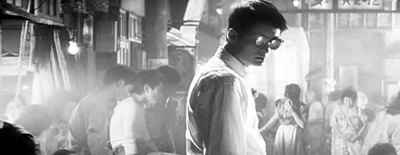Last night I went to a screening of Kurosawa's High & Low at the Plaza theatre in Calgary, put on by Calgary Cinematheque. It's the first Cinematheque event that I've been to, and I'm looking forward to future events.
High and Low is a story about two men: Gondo, a shoe factory manager who's involved in a bitter power-struggle with the traditionalist company owner and three profit-over-quality executives; the second man is a mysterious figure who attempts to kidnap Gondo's son to extract ransom, but instead kidnaps the son of Gondo's chaffeur.
The first and most visually arresting movement of the movie takes place almost entirely within Gondo's dramatic hilltop home, where Gondo's wife, his chaffeur, his son, and even the police encourage him to pay the ransom that will surely ruin him given the context of the factory power struggle, while Gondo rails against them, claiming his own right to preserve his self. Even when he's being selfish, it's with an honesty and forthrightness that still makes him a sympathetic character. He eventually agrees to pay the ransom, but only after he convinces all around him that he has no obligation to do so. I love the way that part of the story played out: that despite the fact that Gondo is an essentially good character, he needed to silence all of the external voices before he could listen to his conscience.
Figures are grouped dramatically in Gondo's stylish home, lit by gaps in the curtain that are generally kept closed to block the view of the watching kidnapper. It's a mesmerizing scene, but the film then shifts rather suddenly from a moral drama to more of a police thriller: the kidnapper outsmarts the police at the exchange, gets away, and sets off an extensive police investigation. I wasn't able to keep track of how many different officers were introduced as being involved in the investigation, but the movie follows up numerous leads, some dead ends, others valid. But what's most interesting is the enthusiasm and emotional investment the police have for recovering the money that belongs to Gondo, who has now become a heroic figure not only in the eyes of the audience, but also in the eyes of every other character in the film.
A third and final movement of the film follows the chief suspect as the police tail him, and, where, clad with mirrored sunglasses, he leads them into seedy dance parlours and a drug alley. This is the Low to the High of Gondo's hilltop home, and the shots of the police here can be contrasted with those in Gondo's home: there are no beautiful groupings of figures, no wonderful light: everything is rugged and grotesquely flawed. Gondo never goes into this world, and the kidnapper never enters Gondo's. So much of this film is about the police, and the way they connect and move between the highs and lows, functioning in very different ways in each.




